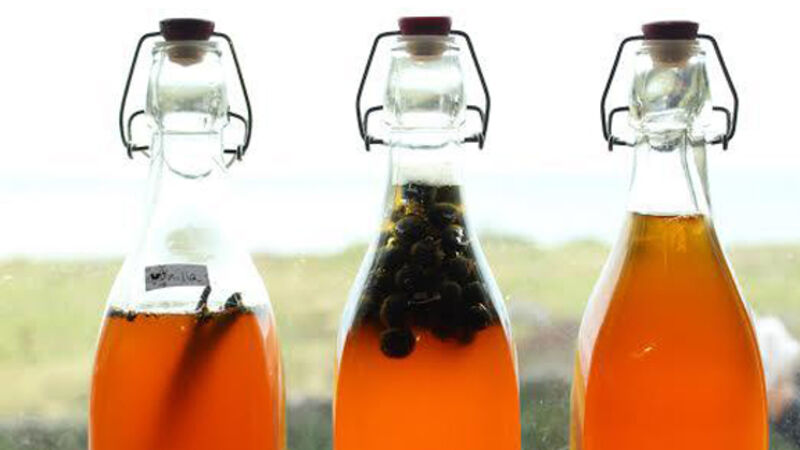Kombucha and Kefir, two probiotic drinks that are easy to make at home

Kombucha and kefir are another element in the wonderful world of fermented foods.
Both are easy to make and maintain, and both have numerous health benefits — from aiding digestion to helping you get a good night’s sleep.
Kefir is made from particles called grains that look a lot like popcorn and feel like jelly.
The origins of kefir are shrouded in mystery — involving a young Russian woman being sent into the Causcaus mountains to procure some of these magical grains from a prince and bringing them back to Russia.
The grains contain yeasts and bacteria with milk proteins and complex sugars.
Kefir is made by pouring milk onto the grains, preferably raw milk, or raw goat’s milk and the milk converts the grains into a yogurt-like drink over a number of days.
The kefir is then strained and the grains rinsed. The process is then repeated indefinitely. The grains will multiply and can be rinsed, split and frozen or given to a friend. If you care for your kefir, it will keep on living for years.

Kefir is a powerful aid to restoring your good gut flora and it acts as a natural probiotic as well as an antibiotic.
It has been creditedwith aiding a lot of problems from acid reflux to constipation and can even be applied topically to rashes and cold sores.
It’s tranquilising effects on the nervous system mean you can enjoy better sleep and less anxiety too and all from some innocent looking jelly things.
The process of fermentation converts the casiens in the milk making it easy for those who are even lactose intolerant, to digest.
Kefir can be consumed in different ways, from drinking it straight, to putting it in smoothies, adding it to your sourdough breads, nut breads and muffin mixtures or pouring over some honey or cordial and enjoying it as a refreshing drink.
For anyone trying to give up sugar and sweets, kefir is a must, it’s unique tart taste alters your taste buds so that you find, quite quickly, the things you once enjoyed like a sugary, chocolatey sweets, now taste waxy and unappealing.
First find some kefir grains, usually you can get them online or maybe find a fellow fermenter or a nutritionist who works with the “heal and seal” method of fixing your gut.
Kefir is made simply — feed the grains by pouring milk onto them in a jar, cover loosely with a cloth and leave overnight or up to five days before straining. Always use a plastic strainer as metal can kill the grains.
If you have a small amount of grains it’s better to feed them slowly, about 100ml milk per day over five days until your kefir is thick, then strain it, rinse the grains under a cold tap and start again.
If you don’t need your grains immediately the best place to store them is in the freezer, just rinse them and pop them in a small jar or a freezer bag and freeze until you need them — or somebody wants to start their own kefir colony.
Kefir can also be used to make cream cheese and the whey is a powerful culinary addition for making your fermented veggies and other foods.
Kombucha has been around for thousands of years and more recently we have seen it for sale in shops.
In Russia, Kombucha is hailed as a wonder-drink that helps to keep your gut healthy, improves energy and vitality, skin elasticity and even helps to restore your hair colour.
It is said that Russian men would drink large amounts it before a night on the vodka, and credit their lack of hangover to this liver-loving drink.
Kombucha is easy to make and costs virtually nothing, you can flavour it with anything from ginger to lemongrass and it gives you a supply of naturally fizzy drinks.
Kombucha should generally be drunk in small doses, however, as it can contain up to 1% alcohol and is a detoxifier.
To start making kombucha you will need to procure a SCOBY (Symbiotic Colony of Bacteria and Yeasts), these can be bought online or procured from any fermenting enthusiast.
Do not try and replace the sugar with honey as this will kill the scoby who eat the sugar (and make more scoby you can keep or pass on to someone else). The measurements given can easily be multiplied to make more.
* 1 x 3 litre glass jar or plastic tub – scrupulously clean and sterilised
* A funnel
* Bottles with flip-top lids, (see picture far left), you can buy these online or collect Grolsch or French lemonade bottles, the airtight lid is essential and the bottles can be recycled. Makes 3 litres or 6 x 500ml bottles
* 1 Kombucha mushroom, available online or from other ‘fermentalists’
* 3 litres boiled water
* 6 x organic unbleached black tea bags, Clipper is a good brand and widely available
* 3/4 cup sugar
* Optional extras: ginger/strawberries/blueberries/dried mango for the second ferment.
. First make sure all your equipment is clean, sterilise your washed jar by putting it into the oven at 160C for 10 minutes.
Pour 1 litre of just-boiled water into the jar, add the sugar and stir to dissolve, pop in your tea bags, cover loosely with muslin or a tea towel, allow to cool.
Top up the jar to 3 litres with cold filtered water and pop in your kombucha mushroom, cover with muslin and secure this in place.
Your scoby will have been sitting in some liquid when not in use, pour some of this into the jar to give it a good start.
. Transfer your jar to a hotpress/airing cupboard that is generally warm at around 20-22 degrees for the first ferment. In summer you can leave the kombucha to ferment at room temperature in the kitchen.
Leave the jar here for 5 - 7 days and then you are ready to bottle the kombucha. Taste it at this stage, if it tastes sweet and pleasant, now is a good time to bottle it.
Make sure your bottles and caps are all sterilised and cooled down, boil them in water for ten minutes to do this.
Taste the kombucha at this point, if it doesn’t seem sweet enough maybe add half a teaspoon of sugar to each bottle. You can also add some fruit like strawberries, rhubarb or ginger to flavour the drinks.
Return the bottles to the hot-press for 3 more days. After this time transfer the bottles to a cool place to slow down the fermenting process.
Pop your mushroom into a jar with some cold tea and sugar and cover with muslin secured with string. The mushroom will multiply, giving you one to give to a friend or simply make a bigger batch next time.












